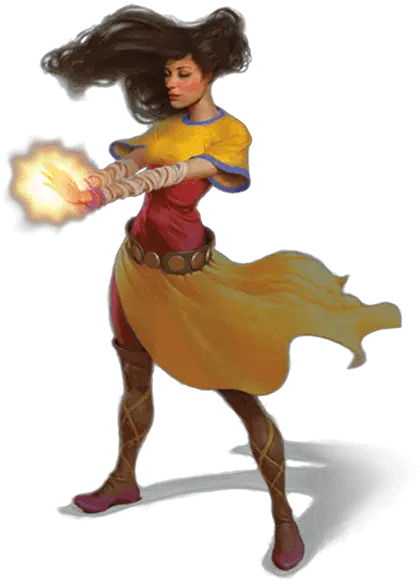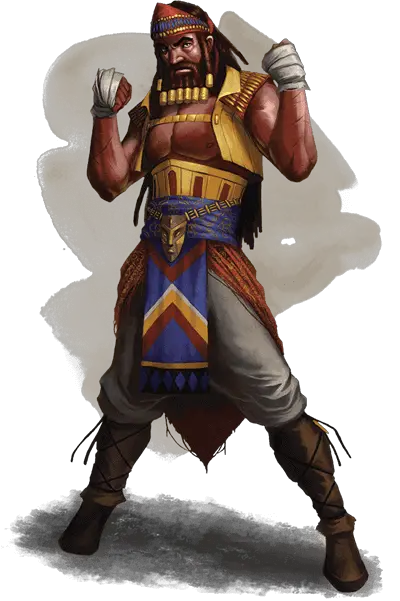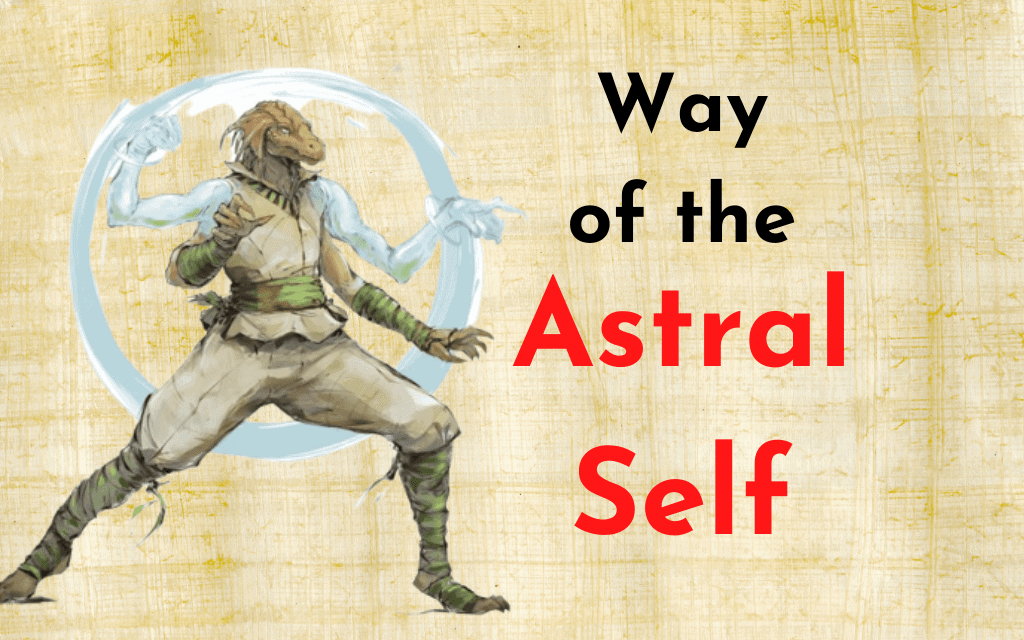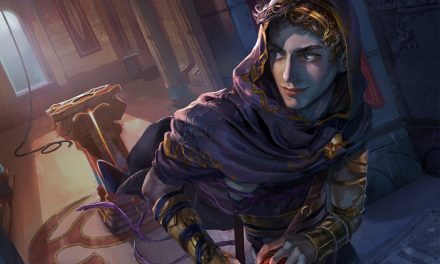With intense spiritual and physical training, the Astral Self Monk uses their ki to physically manifest their true self. They not only enhance their physical body but actually become their body.
The form this astral self takes in terms of appearance is entirely up to role-play, creativity and theme.
For instance, imagine a gnome monk who has the spirit of a powerful lion within themselves or an elf who feels a deep kinship with elementals. A human might channel the powerful force of a dragon while a tiefling’s form might shine bright as an angel.
They can all manifest their astral selves in accordance to these themes or any other manner they wish!
With the power of their true self manifested, the Astral Self Monk gets a TON of new abilities and options. Whether issuing a beatdown on their enemies or protecting themselves and their allies, four arms are better than two!
This is the full subclass guide to the Astral Self Monk in D&D 5e.
What is the Astral Self Monk in D&D 5e?
Astral Self Monks defy the limits of their physical form and manifest their ki as their true “astral” self. Initially only manifesting one or two body parts at a time, eventually their entire form shifts as they grow in power.
These Astral manifestations enhance many of the Monk’s abilities and allow them to play and build a bit differently than other monks.
But what actually is this Astral Self?
At its core, the Astral Self is a manifestation of ideals, teachings, flaws, traits, soul or any combination thereof. Developed and nurtured through the teachings of this Monastic Tradition, it is the sum of the Monk’s experiences, beliefs, and soul physically manifested.
The form this self takes is unique to each Astral Self Monk and doesn’t necessarily have to look anything like their physical body.
This offers a high degree of customizability and creativity for those who are playing an Astral Self Monk.
The Astral Self Monk is one of two Monk subclasses from Tasha’s Cauldron of Everything. (With the other being the Way of Mercy Monk.)
Role in the Party
Astral Self Monks make excellent damage dealers in combat, using their Astral Self for combat purposes with different flavor and better range than other Monks.
Like most Monks, the Astral Self Monk is an excellent skirmisher who is able to quickly overwhelm opponents and navigate the battlefield.
Out of combat, Astral Self Monks, with their high Dexterity and Wisdom scores, are great at stealth, acrobatics, athletics, insight and perception. This makes them reliable trailblazers, scouts, and spies.
Depending on your background, you might even have medicine and survival proficiencies.
Additionally, these Monks can make for capable negotiators, enforcers, or lie detectors. With their keen insight, they’re able to easily sniff out deception. In fact, they specifically gain buffs to their Insight and Intimidation later as they level up!
(So you should also check out my article covering how/when to use the Insight skill!)

Astral Self Monk Features 5e
The Astral Self Monk’s abilities offer a whole new flavor and capability to the standard Monk package.
Using their astral bodies, they can attack in ways that other Monks usually cannot. They also gain stronger defenses and capabilities as more of their Astral Self is able to be manifested.
As with all Monks, you’ll want to focus on managing your ki points. That’s how you power all of your cool Monk features after all!
Arms of the Astral Self (Level 3)
At level 3 when you take the Way of the Astral Self, you are able to awaken a portion of your astral power. Specifically, you get extra arms!
As a bonus action, you can spend 1 ki point to summon the arms of your astral self. When you do so, each creature of your choice that you can see within 10 feet of you must succeed on a Dexterity saving throw or take force damage equal to two rolls of your Martial Arts die.
For 10 minutes, these spectral arms hover near your shoulders or surround your arms (your choice). You determine the arms’ appearance, and they vanish early if you are incapacitated or die.
Talk about starting things off with a bang!
Because you’re dealing extra damage to nearby enemies when you summon your Astral arms, you might not want to activate this feature until you’ve already engaged. If enemies try to surround you, they’re in for quite the surprise!
But that’s just the tip of this iceberg…
While the spectral arms are present, you gain the following benefits:
You can use your Wisdom modifier in place of your Strength modifier when making Strength checks and Strength saving throws.
You can use the spectral arms to make unarmed strikes.
When you make an unarmed strike with the arms on your turn, your reach for it is 5 feet greater than normal.
The unarmed strikes you make with the arms can use your Wisdom modifier in place of your Strength or Dexterity modifier for the attack and damage rolls, and their damage type is force.
1 Ki point for Astral arms that last 10 mins, hit enemies surrounding you with an AoE, deal force damage, and have extra reach?
Yes, please!
Also, because you’re dealing force damage with your Astral arms, this is a great way to get around certain creatures’ resistances. Specters and Werewolves, for example, are resistant to nonmagical damage from attacks but you have an early way of getting around that!
Addressing the MAD Monk
Arms of the Astral Self also addresses an issue that Monks usually face.
MAD (multiple attribute distribution) is a way of saying that Monks usually need to spread their focus across several ability scores.
Consider:
Dexterity is vital for Monks’ physically but Wisdom is what also powers their ki features. Both of those are super important for the Monk. But Strength can be important for certain physical challenges and we can’t forget Constitution if we don’t want to get ourselves in serious trouble, right?
So maybe we dump Intelligence and Charisma, but that’s still four abilities for us to worry about when building our Monk!
Arms of the Astral Self let you use Wisdom to calculate your attack rolls and damage. This lessens your need for a high Dexterity in combat and lets you focus on your Wisdom score.
Additionally, you’re able to use your Wisdom modifier instead of your Strength modifier for things like Strength saving throws or checks that would otherwise use your Strength modifier (like Athletics.)
When building an Astral Self Monk, prioritize your Wisdom score above all else. Make Constitution and Dexterity your next most important scores. Don’t worry about Strength, that’s what you’ve got Astral arms for now!
Related: 5 Ways to Determine Ability Scores in D&D 5e

Visage of the Astral Self (Level 6)
At level 6, the Astral Self Monk has further harnessed their ki. Now they can call forth the face of their true Astral form.
“As a bonus action, or as part of the bonus action you take to activate Arms of the Astral Self, you can spend 1 ki point to summon this visage for 10 minutes. It vanishes early if you are incapacitated or die.
The spectral visage covers your face like a helmet or mask. You determine its appearance.
Not only does this look cool, but it also gives the Astral Self Monk three more unique abilities.
The ability to duplicate Warlock’s Devil’s Sight invocation, be able to intimidate and discern lies with advantage, and simulate the effects of both the Message and Thaumaturgy cantrips for a single ki point is incredible!
Astral Sight
Astral Sight enables you to see normally in darkness (magical and non-magical) to a distance of 120 feet.
Always having an answer if darkness is used against you is very powerful.
In fact, you could coordinate with you party’s spellcaster to cast Darkness on a group of enemies. While you beat the daylights out of them, they won’t see a thing!
Wisdom of the Spirit
Wisdom of the Spirit gives you advantage on Wisdom (Insight) and Charisma (Intimidation) checks.
Sometimes you need a bit of intimidation and your Astral Self certainly helps! It also makes you hard to trick or deceive thanks to your Insight.
Additionally, you can enhance the effect with your next ability from this feature. You can shout out in a booming voice to dishearten whoever you’re intimidating or covertly reveal liars and thieves to other members of the party with a private message only they will hear.
Word of the Spirit
Lastly, using Word of the Spirit when you speak, you can direct your words to a creature of your choice that you can see within 60 feet of you, making it so only that creature can hear you.
Alternatively, you can amplify your voice so that all creatures within 600 feet can hear you.
It might be easy to dismiss this benefit as flavor, but it can be used very creatively in the right situations!
I guess you could also do the opposite of the scenario I mentioned above. If you catch someone lying, yelling “LIAR!” so loud that everyone within 600 feet can hear it might convince them to start telling the truth.
Related: Monk Weapons in D&D 5e Explained!

Body of the Astral Self (Level 11)
So far you’ve gotten the arms and face of your Astral Self, now let’s bring out the rest of it! With your level 11 feature, Body of the Astral Self, we’re going to do just that…
When you have both your astral arms and visage summoned, you can cause the body of your astral self to appear (no action required). This spectral body covers your physical form like a suit of armor, connecting with the arms and visage. You determine its appearance.
Similar to your previous features, summoning the body of your Astral Self gives you extra benefits for the duration.
Deflect Energy
Deflecting arrows is good but deflecting acid arrows is even better!
When you take acid, cold, fire, force, lightning, or thunder damage, you can use your reaction to deflect it. When you do so, the damage you take is reduced by 1d10 + your Wisdom modifier (minimum reduction of 1).
The ability to react to incoming elemental damage types is like having free Absorb Elements at-will as long as you have a reaction available. This can add up to a ton of damage deflected during combat, especially against enemies that favor elemental attacks.
Imagine the look on a Red Dragon’s face if you just smack its fire breath away!
Empowered Arms
Speaking of a ton of damage…
Once on each of your turns when you hit a target with the Arms of the Astral Self, you can deal extra damage to the target equal to your Martial Arts die.”
Being able to sink an extra Martial Arts die worth of damage into your target when you hit each turn is a considerable boost! It will add up quickly throughout the fight and help you take enemies down faster!
When all else fails, hit ‘em harder!
Also Check Out: The Full Monk Class Guide for D&D 5e!

Awakened Astral Self (Level 17)
Now you can leverage the full power of the Awakened Astral Self.
“Your connection to your astral self is complete, allowing you to unleash its full potential. As a bonus action, you can spend 5 ki points to summon the arms, visage, and body of your astral self and awaken it for 10 minutes. This awakening ends early if you are incapacitated or die.
While your astral self is awakened, you gain the following benefits:
Armor of the Spirit.
You gain a +2 bonus to Armor Class.
Astral Barrage.
Whenever you use the Extra Attack feature to attack twice, you can instead attack three times if all the attacks are made with your astral arms.”
Using a single bonus action and for only 3 more ki points spent than you’ve gotten used to by this point, you essentially have the primary effect of the Haste spell… for 10 minutes. Oh, and that’s without the drawback of becoming fatigued when it ends.
But do you know what is even better? It isn’t Haste, so it can stack with Haste. That’s a total of +4 AC in addition to launching an all-out assault.
This is absolutely insane.
So, you get your two regular attacks (one of which is empowered from Empowered Arms for double damage), a third attack from your Astral Barrage, plus two more if you throw in a Flurry of Blows.
Have your friendly Wizard or Sorcerer cast Haste on you for yet another extra attack and you are now putting Super Saiyans to shame!
Related: Extra Attack in D&D 5e Explained
Connections
The Astral Self Monk’s path is a deeply personal one. Leveling up isn’t just a mechanic, it’s symbolic of the type of inner journey that the Monk is on. Through meditation, practice, and discipline, you are uniting your physical and spiritual selves into a singular entity.
Maybe there is a story of reconciling the spirit to the body because they are at odds?
Maybe you are on a pilgrimage to hone your spirit to make it more powerful and true to who you are and what you represent.
Perhaps your astral spirit manifests more like going berserk or transforming like a were-creature until you gain better understanding and wisdom to control it?
The possibilities are truly endless for however you want to flavor the Astral Self.
When making an Astral Self Monk character, consider their inner goals just as much as their outward goals. Are the two a reflection of each other or do they pull the character in different directions?
You Might Also Like: Mastering the Monk’s Stunning Strike in D&D 5e
Is the Astral Self Monk Good?
There is a lot that is truly excellent with the Astral Monk.
The abilities you get are very cool, powerful, and not overly complicated to use. Meanwhile, the extra capabilities you gain from your Astral Self features do a lot to change how these Monks fight in combat.
Thematically Astral Self Monks are outstanding and offer a creative option built right into the subclass.
Additionally, like we covered earlier in this article, the subclass uniquely addresses the MAD inherent to monks. You can have a much more focused build instead of trying to juggle too many ability scores.
The biggest real downside is that when your ki is gone, you will be a far weaker. All of your abilities rely on having an aspect of your Astral Self summoned. If you find yourself tapped for ki points, you don’t have any special subclass features to fall back on.
This subclass offers amazing abilities when you have ki available, but it’s a different story when you don’t. Manage your ki wisely!
Astral Self Monks are best at mid to high levels when the Monk’s Martial Arts die is bigger. They aren’t terrible in the earlier levels, but level 11 is when they really hit their stride.
These characters can be built to really explore the roleplaying options and the outright power inherent in the subclass’s abilities. Finding a way in your party to get that Darkness/Astral Sight combo going could be incredibly strong.
Good things come with time. If eventually being able to punch enemies with your custom ki body a zillion times per round sounds exciting to you, then this is very likely the class for you!
You can see how the Astral Self Monk compares to the other Monastic Traditions in the full ranking of every Monk subclass in D&D 5e!
Conclusion – Guide to the Astral Self Monk in D&D 5e
The Astral Self monk is pretty great all around. It has a really cool theme that allows for a high degree of customization and creativity. At higher levels, they’re quite the powerhouse.
Persona 5 is the only game in that series that I’ve played, but there’s a lot in this subclass that reminds me of that. One of my favorite things in the game was seeing how the characters would awaken/bond with a spirit that was reminiscent of themselves to aid them. (I assume that’s a common theme/mechanic in those games?)
Is that just me or no?
Have you have played an Astral Self Monk or have ideas about doing so in the future? Want to share your character concept? Let’s chat in the comments!
Want all the latest player guides, DM tips, news, reviews, and more for D&D 5e? Sign up for the Tabletop Joab newsletter below!
You can also follow me on Facebook and Twitter.
If you found this article helpful and want to support the site, you can buy me a coffee here! (It’s not expected, but very appreciated!)









